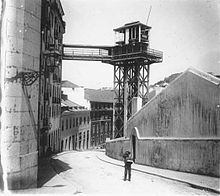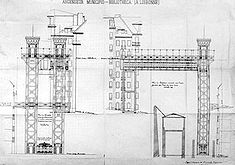- Municipal Library Elevator Coup
-
Municipal Library Elevator Coupe 
The Municipal Elevator, also referred to as the Library Elevator as seen from the Calçada de São FranciscoOther names - The Elevator Coup
- 28 January 1908 Coup
Participants - King Carlos I of Portugal
- João Franco
- José Maria de Alpoim
- Afonso Costa
- Francisco Correia Herédia
- António José de Almeida
- Luz de Almeida
- João Chagas
Location Lisbon, Portugal Date April 1, 1908 Result Arrests initially, leading to the Lisbon Regicide The Municipal Library Elevator Coup, The Elevator Coup or 28 January 1908 Coup (Portuguese: Golpe do Elevador da Biblioteca, Intentona do Elevador or simply the Golpe de 28 de Janeiro de 1908), was the name given for the attempted coup d'etat by members of the Portuguese Republican Party (Portuguese: Partido Republicano Português) and Progressive Dissidency (Portuguese: Dissidência Progressista), against the administrative dictatorship of Prime Minister João Franco (and the political ascendancy of the Liberal Regenerator Party). The event was not confined to the Municipal Library Elevator, but was so named for the arrest of many conspirators at the structure on the afternoon of January 28, 1908. Although the coup was prevented by government forces, it failed to capture all the conspirators, which contributed to the assassination of the monarch Carlos I of Portugal and the heir to the throne, the Prince Royal, Luís Filipe. These events would continue legislative instability and lead to the Portuguese First Republic, the raison d'etre of the coupe conspirators.
Contents
Background
Since King Carlos I of Portugal had decided to support the Liberal-Regenerator leader João Franco and allow him to run the government as an administrative dictatorship (without parliament, but maintaining civil liberties), the parties in the Cortes had vocally rebelled. The traditional parties (the Regenerator and Progressive Parties) were the most critical, since they were fearful of losing their political clout within the rotativist system that existed (an inefficient system of rotating governments, where the main parties would alternate in government, through gentlemens agreements). The Progressive Dissidency, who had been created exclusively by José Maria de Alpoim to obtain power, was likewise positioned in a way to remain on the fringes of power. Although it was officially monarchist, the Party and its leader were willing to abandon its platform and scruples in order to align itself with the Portuguese Republican Party, at the time a radical group of socialists, anarchists and nationalists intent on taking power by force. João Franco, was also interested in marginalizing the Republicans, by co-opting many of the planks of the other parties in order to form a program that would remove the political instability that existed and maintain power. The election of April 5, 1908, which could have ushered in a legislative victory for João Franco's Liberal-Regenerators, and possibly install a functional parliament, united the leaders of the Dissidency and Republican Party in a conspiracy to take power by force. For this the Dissidency provided the money and arms, and the Republicans, with their contacts within Portuguese secret societies (principally the Carbonária and Masonry) would provide the men.
Plans
Originally, the conspirators hoped to force the abdication of the King Carlos I, but decided on proclaiming a republic as the better goal. Various versions of the plan existed, although they all shared the same goal of removing the dictator João Franco without forcing the intervention of the military, and thus escalating the conflict into a civil war. In its final version, brigades of Carbonária would neutralize the lines of communication, the mounted cavalry in the Largo do Carmo, the Municipal Guard in the Largo dos Lóios, the barracks in the Cabeço de Bola and the naval officers in the Vale de Zebo, while the remaining conspirators would take the municipal office buildings and eliminate João Franco.
On January 27, 1908 the plan to remove the dictator was approved by Afonso Costa and Francisco Correia Herédia (Viscount of Ribeira Brava) for both groups of dissidents. Meanwhile, other conspirators were not only interested in removing João Franco, but also eliminating the King. This change in plans is harder to pinpoint, but a recent study[1] points to the end of 1907. José Maria Alpoim, who associated with members of the Carbonária, was responsible for a plan to acquire arms, promulgate a revolution, and two plans to execute the Prime Minister and the monarch. Whether republican leaders were aware of these plans is unclear; the relationships that existed between the conspirators and instigators of the coupe were later suppressed. But, these competing motivations likely played a part in the disorganization on the eve of the coupe, which was planned for either January 31 or February 1.
Regardless, the confidence of the conspirators was so high that a shop-owner, Vitor dos Santos, attempted to bribe a police officer to join the conspiracy. The officer, after seeing a box of explosives (which the proprietor presented him) reported of the conspiracy to his superiors. Informed of the possible conspiracy in the works, João Franco ordered the imprisonment of Republican leader António José de Almeida, the Carbonária head Luz de Almeida, the republican journalist João Chagas and other suspects, as well as ordering the reinforcement of strategic points throughout Lisbon.
Attempted coup
With the leadership of the movement almost decapitated, it fell to Afonso Costa to salvage the group's plans. The government had placed many sights under observation and the military was supported by government forces. A few, still belligerent conspirators, attempted to attack these forces in the bairro of Rato, in the civil parish of Alcântara, at the Campo de Santana and along the Rua da Escola Politécnica: one policeman was killed.
Alfredo Costa, supported by members of the Progressive Dissidency, took their positions under the conspirator's plan, at the Municipal Library Elevator. The Municipal Elevator, also known as the Library Elevator or Elevator of São Julião, was the seventh public elevator to be constructed in Lisbon. It was inaugurated on January 12, 1897 under the supervision of its designer, Raoul Mesnier de Ponsard[2], and operated until 1915 when it was permanently taken out of service.[3] It connected the Largo da Biblioteca near the Municipal Library (today, the Academy of Fine Arts) with the municipal square, Largo de São Julião (today, the Praça do Município), through the buildings at 13 Largo de S. Julião and the terrace of the Palácio do Visconde de Coruche.[4]
Waiting for confirmation from the leadership to execute their plans, and hopeful of a turn in the events, many of the remaining conspirators begin to congregate at the Elevator. Their appearance was scrutinized by a policeman, who became suspicious because the Elevator was ostensibly out of service. Calling for reinforcements, a group of officers detained and arrest the group of men, which included Afonso Costa, António Egas Moniz, Álvaro Poppe, Francisco Correia de Herédia (the Viscount of Ribeira Brava) and others.[5] While José Maria de Alpoim was able to escape to Spain, in all 100 people arrested during the crackdown, including the Viscounts of Pedralva and Ameal, João Pinto dos Santos, Cassiano Neves and Batalha de Freitas. The coup is crushed.
Aftermath
With the coup conspirators imprisoned, the King signed a decree (written by João Franco) to establish sentences of exile or expulsion to the colonies for those individuals caught for countervening regulations of public order (signed at the palace of Vila Viçosa on January 30)[6] In order to perpetuate the semblance of order, the King and Royal Family, returned to the capital on February 1, 1908, following a route through the Terreiro do Paço until the Palácio das Necessidades. But, even with leadership imprisoned, the square was circled by gunmen of the Carbonária who assassinated the King and Prince Royal in what became known as the Lisbon Regicide. Although João Franco was physically spared (the assassins had ignored his carriage), he was held responsible for lack of police security and a naive over-confidence that allowed the monarch to travel in an uncovered landau.
Although the coup failed, the death of the King and heir apparent was responsible for continuing instability which was ultimately a success for the republicans. The traditional parties were able to impose an acclamation solution, with the establishment of a unity government presided by an independent (Francisco Joaquim Ferreira do Amaral), the ostracising of João Franco's supporters, and the repeal of Francist decrees. In fact, the acclamation policies was a rendition: many of the conspirators were liberated from prison, the assassins (who were killed in the square) were eulogized as martyrs and the criminal investigation was neutered. These events only encouraged the republicans to attempt another coup d'etat 33 months later, led by the same people, that would succeed in establishing the Portuguese First Republic. The events that gave rise to the attempted coup on January 28 were the last attempts to reform the constitutional monarchy.
References
- Notes
- Sources
- Morais, Jorge (2007) (in Portuguese). Regicídio: A Contagem Decrescente [Regicide: The Untold Story]. Lisbon, Portugal: Zéfiro. ISBN 978-972-8958-40-4.
- Pinto, José Manuel de Castro (2007) (in Portuguese). D. Carlos (1863-1908): A Vida e o Assassinato de um Rei [D. Carlos (1863-1908): The Life and Assassination of a King]. Lisbon, Portugal: Plátano Editora. ISBN 978-972-770-563-4.
- Ramos, Rui (2006) (in Portuguese). D. Carlos. Lisbon, Portugal: Círculo de Leitores. ISBN 972-42-3587-4.
- Correia, Octaviano (9 August 2007), Correia, Henrique, ed. (in Portuguese), Do Pombal ao Bom Jesus de Braga [From Pombal to Bom Jesus of Braga], Jornal da Madeira, http://www.jornaldamadeira.pt/not2008sup.php?Seccao=16&id=76558&sup=5&sdata=2007-09-08, retrieved 22 July 2010
- Ferrero, Paulo (28 April 2008) (in Portuguese), O Elevador de São Julião [The Elevator of São Julião], Lisbon, Portugal: Obersvatório de Baixo, http://observatoriobaixa.blogspot.com/2008/04/o-elevador-de-s.html, retrieved 22 July 2010
Categories:- History of Portugal
- Republicanism in Portugal
Wikimedia Foundation. 2010.

